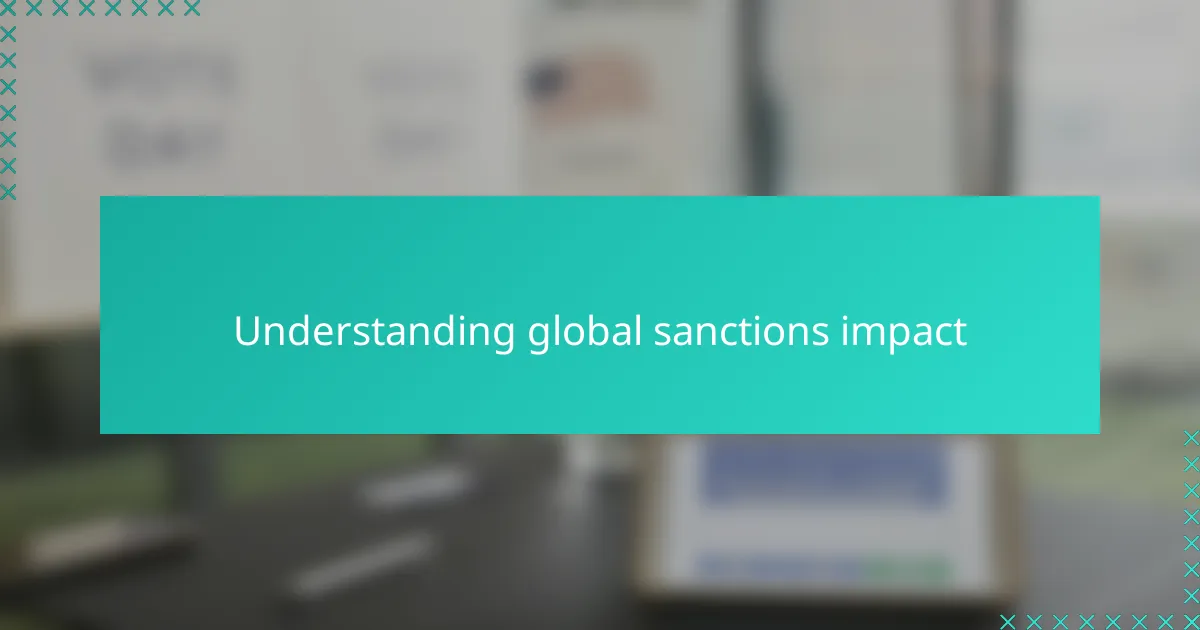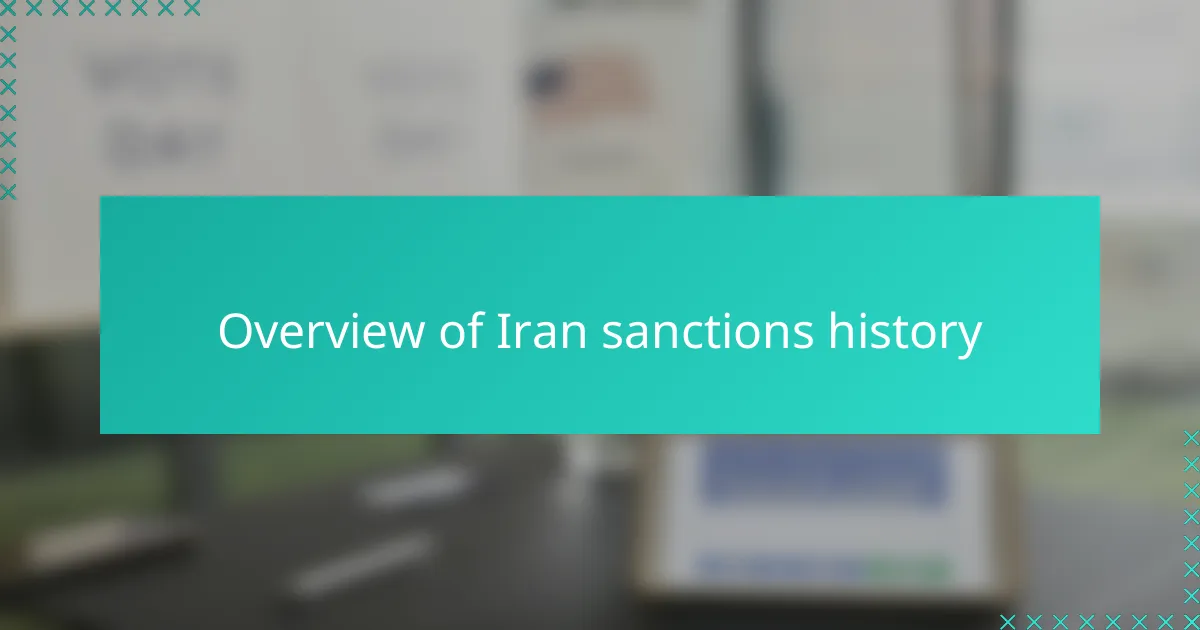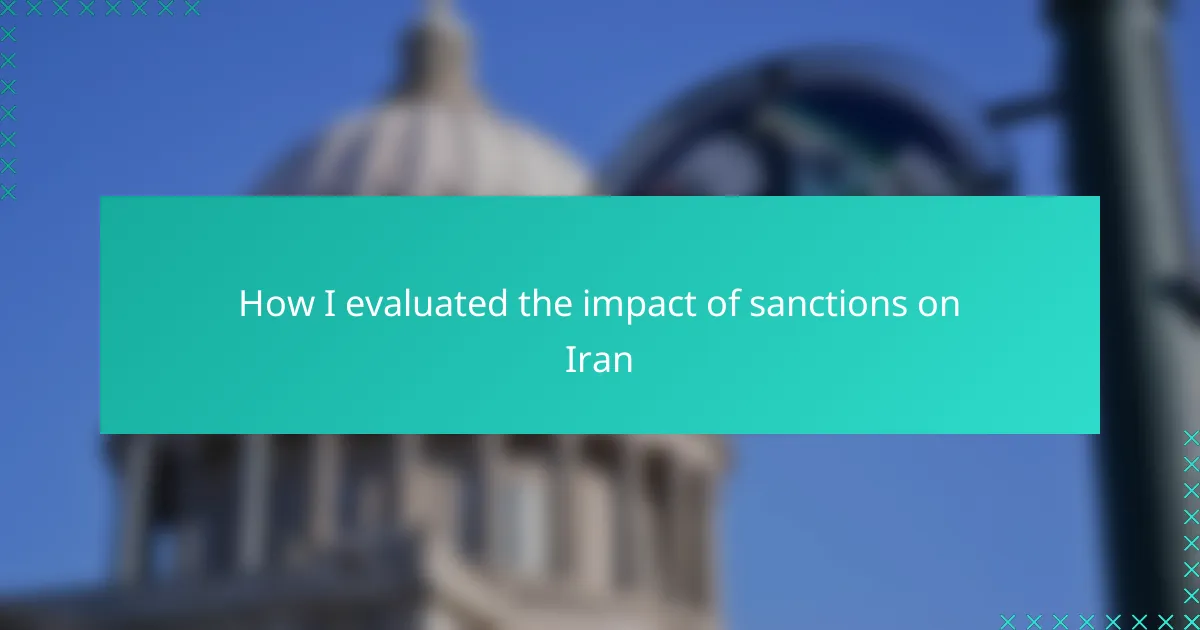Key takeaways
- Sanctions have multifaceted impacts, influencing not just economies but also social dynamics and ordinary lives.
- The history of Iran sanctions illustrates a pattern of escalating tensions, with unintended side effects on both the regime and its citizens.
- Combining quantitative data with qualitative narratives provides a more comprehensive understanding of sanctions’ effects.
- Future analyses should embrace complexity, balance strategic objectives with empathy, and critically evaluate data sources.

Understanding global sanctions impact
When I first delved into the complex world of global sanctions, I quickly realized how multifaceted their impact truly is. It’s not just about economic restrictions; it’s about how these measures ripple through societies, affecting ordinary lives in unexpected ways. Have you ever wondered how a policy made in one part of the world can reshape daily realities thousands of miles away?
Understanding sanctions means looking beyond the headlines to the subtle shifts in trade patterns, inflation rates, and even social behavior. I found that sanctions often create a tangled web of consequences, where some sectors suffer more than others, and unintended side effects quietly emerge. This complexity challenged my initial assumptions and pushed me to think more critically about the tools of global diplomacy.
What really struck me is how sanctions serve as both a political signal and an economic weapon. They communicate international disapproval, but at the same time, they impose tangible costs. This dual function makes evaluating their true impact a delicate balance of interpreting data alongside the human stories behind the numbers. Have you noticed how what seems like a straightforward measure becomes anything but simple once you dig deeper?

Overview of Iran sanctions history
Tracing the history of sanctions on Iran reveals a pattern of escalating tensions and shifting geopolitical calculations. From the early 1990s, when sanctions targeted Iran’s nuclear ambitions and support for militant groups, I noticed how each new round seemed to tighten the economic noose, yet also spurred unexpected resilience. Have you ever paused to think about how repeated sanctions over decades could shape not just policy but the very fabric of a nation’s economy?
What really resonated with me was how sanctions evolved from focused embargoes on military and nuclear sectors to broader measures affecting banking, oil exports, and even humanitarian goods. This widening net made me realize the complexity of distinguishing between pressure on a regime and hardship imposed on ordinary citizens. It raised the question: can sanctions be precise enough to target only the intended players without collateral damage?
Looking back, I found that moments of relief—like the 2015 nuclear deal—offered a brief glimpse of hope but were often followed by renewed restrictions that reignited economic woes. This cyclical pattern deepened my understanding of how sanctions are not just static laws but continuously shifting instruments shaped by diplomacy and political will. How do you think such on-again, off-again pressure affects long-term planning for a country like Iran?

Methods for evaluating sanctions effects
Evaluating the effects of sanctions felt like piecing together a complex puzzle without a clear picture. I started by examining macroeconomic indicators—things like GDP fluctuations, inflation spikes, and trade volume changes. But I quickly realized numbers alone can be misleading; they don’t capture the human experience behind economic data.
To get a fuller understanding, I turned to qualitative methods, such as analyzing reports from NGOs, firsthand accounts from Iranian citizens, and media coverage. These stories added layers of nuance, showing me how sanctions influenced everyday life—from job losses to access to medicine. Have you ever thought about how a statistic might hide the desperation of a single family? That’s what these narratives revealed to me.
Another approach I found useful was tracking shifts in Iran’s trade partners and financial networks through open-source intelligence and sanctions compliance reports. This helped me see not just who was sanctioned, but how Iran adapted—sometimes finding new allies or creative workarounds. It made me wonder: are sanctions truly as isolating as intended, or do they sometimes spark unexpected forms of resilience?

Data sources and analysis techniques
In gathering data, I relied heavily on a mix of official economic statistics and in-depth reports from international organizations to capture the broad strokes of Iran’s economic shifts. Yet, I found pure numbers often left gaps—gaps I filled by diving into qualitative sources like interviews and NGO assessments, which brought the human dimension vividly to life. Have you ever noticed how raw data can feel cold until it’s paired with real stories?
My analysis techniques blended quantitative methods, such as trend analysis and comparative metrics, with qualitative content analysis to interpret narratives around the sanctions’ social impacts. This dual approach wasn’t always straightforward; I had to critically evaluate source reliability and cross-check findings to avoid misleading conclusions. It made me appreciate how careful one must be when turning diverse data points into a cohesive picture.
I also incorporated network analysis tools to trace shifts in Iran’s trade connections and financial channels, revealing the ways sanctions reshaped its global relationships. It surprised me how adaptable the system was—showing resilience that straightforward metrics might overlook. Doesn’t it make you wonder how a nation under pressure can still find new pathways to survive and even thrive?

Case study findings on Iran sanctions
What stood out most in my case study was how sanctions sharply curtailed Iran’s oil exports, yet didn’t completely sever its international trade. I was struck by how Iran managed to reroute commerce through non-traditional partners and covert channels, revealing a determination that numbers alone can’t fully explain. Have you ever considered how resilience can quietly undermine the strictest embargoes?
I noticed the sanctions’ impact wasn’t uniform; while the energy sector faced severe setbacks, certain domestic industries adapted by focusing inward or seeking alternative markets. This uneven effect made me question: can sanctions truly cripple an economy if parts of it find ways to adjust and survive? It’s a reminder that the story behind the data is always more layered than it first appears.
Perhaps most poignant were the findings on everyday Iranians—how inflation and restricted access to medicines affected families’ wellbeing. Reading those stories brought home the human cost behind the policy debates. It made me wonder, how do we weigh the strategic aims of sanctions against the real hardships experienced on the ground?

Personal evaluation approach and insights
In evaluating the impact of sanctions on Iran, I found that combining quantitative data with personal stories was essential. It wasn’t enough to look at the numbers; I needed to understand how real people navigated the hardships behind those figures. Have you ever thought about the difference between knowing a statistic and hearing a lived experience? That realization reshaped my entire approach.
I also reflected on my own initial biases—assuming sanctions would simply debilitate economies. Yet, as I dug deeper, I saw resilience and adaptation emerge in unexpected ways. This insight challenged me to think beyond the conventional narrative of sanctions as purely punitive tools. Isn’t it fascinating how strategy and human ingenuity intertwine in complex geopolitical puzzles?
Ultimately, my evaluation was a balance between empathy and critical analysis. By blending data with diverse perspectives, I aimed to get as close as possible to the multifaceted reality. It left me wondering: how do we craft policies that hold regimes accountable without deepening citizens’ suffering? This question felt more personal with every story I encountered.

Lessons learned for future sanctions analysis
One key lesson I came away with is that future sanctions analysis must embrace complexity rather than shy away from it. You can’t just rely on headline economic indicators; you need to weave in human stories and adaptive behaviors to truly grasp the impact. Have you ever noticed how a single number can mask the resilience or suffering lurking just beneath the surface?
I also learned the importance of maintaining a critical eye toward data sources and methods. Not all reports tell the full story, and biases—whether in official statistics or personal testimonies—can steer the analysis off course. It made me realize that ongoing cross-verification and openness to unexpected findings are indispensable when interpreting sanctions effects.
Finally, reflecting on this journey reminded me that future analyses should balance strategic objectives with empathy. Sanctions aim to influence political behavior, but they inevitably affect ordinary lives in profound ways. How do we measure success without losing sight of that human cost? Wrestling with this question feels essential for anyone seeking to evaluate sanctions with both rigor and compassion.
